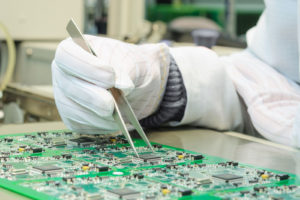
Reverse engineering involves the analysis and disassembly of products to see how they operate. This can be useful in a number of situations, including the creation of similar products or to improve the quality of an existing product. Reverse engineering can also be used to determine patent infringement or in situations where product service documentation has been lost or is unavailable.
Reverse engineering has been used for many years in several fields including electronics, mechanical designs, software engineering, entertainment, automotive, microchips, chemicals and consumer products. Even printed circuit boards can be analyzed to see how components are interconnected.
Reverse Engineering of Electronics
ACDi can assist with the ethical reverse engineering of electronics. We have over 30 years of experience and work with a wide range of industries. We are able to analyze a wide variety of products and provide a comparable design, including design files and other supporting documentation. These services can be provided with minimal or no involvement of your engineering team.
Any information that can be provided helps reduce the time and cost it takes to complete the reverse engineering process. Although we understand that documentation isn’t always available, any of the following can be extremely useful:
- Schematics
- Bill of materials
- Assembly drawing
- Board drawings
- Theory of operation
- Operators manual
- Maintenance manuals
- A working system
- Any information pertaining to the device’s operation
Reverse Engineering Example
One possible project is to recreate an older technology circuit board for which electronic design files do not exist and what documentation that does exist is incomplete. The only existing board available may not even work. A circuit board like this likely has a great deal of through hole components and integrated circuit (IC) packages that are larger and consume more energy.
The first step in this example would be to identify any components that can be visually identified (component markings), measured or read from any available documentation. Any components that are determined by documentation are verified by measurement to ensure they match since the documentation may be out of date. (If no documentation is available, many components can be removed from the board and measured).
The next step would be to determine how all of these components are interconnected. This may be achieved by reading any existing documentation (and verifying), using a meter to determine connectivity, and/or X-rays.
At this point, there will likely be a few left over components that are unknowns, but can usually be determined based on the other surrounding components. This is typically the hardest step.
Once all of this is complete, a schematic can be generated. At this point, the through hole components are converted to SMD components as much as possible, ICs are changed to more efficient packages when possible, and an obsolescence report is generated to determine if any other circuit components need to be changed. Once the schematic is complete, the new circuit card layout can be generated and production files are ready.
Some products may also require software which will need to be reverse engineered. Any available source code or documentation helps with this even if moving to a new platform. If no information is available, files may be able to be extracted from the older product, but no changes would be able to be made. If changes will be required, a new software design will be required.
After the design is complete, it is important to build a new circuit card assembly and test it to ensure the operation is as expected.
Electronics Manufacturing
ACDi is an electronics manufacturing services (EMS) firm offering product engineering, system integration, product lifecycle management and rework services to a balanced mix of market sectors. We work directly with our clients throughout the entire manufacturing process, from concept to completion. Our expertise and superior attention to detail allows us to consistently meet and exceed expectations.
For more information about reverse engineering contact us or call 301-620-0900.
